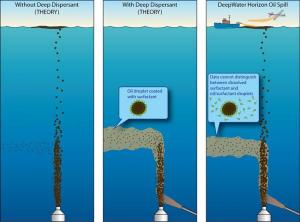To combat last year’s Deepwater Horizon oil spill, nearly 800,000 gallons of chemical dispersant were injected directly into the oil and gas flow coming out of the wellhead nearly one mile deep in the Gulf of Mexico.
Now, as scientists begin to assess how well the strategy worked at breaking up oil droplets, Woods Hole Oceanographic Institution (WHOI) chemist Elizabeth B. Kujawinski and her colleagues report that a major component of the dispersant itself was contained within an oil-gas-laden plume in the deep ocean and had still not degraded some three months after it was applied.
While the results suggest the dispersant did mingle with the oil and gas flowing from the mile-deep wellhead, they also raise questions about what impact the deep-water residue of oil and dispersant — which some say has its own toxic effects — might have had on environment and marine life in the Gulf.
“This study gives our colleagues the first environmental data on the fate of dispersants in the spill,” said Kujawinski, who led a team that also included scientists from UC Santa Barbara. “These data will form the basis of toxicity studies and modeling studies that can assess the efficacy and impact of the dispersants.
“We don’t know if the dispersant broke up the oil,” she added. “We found that it didn’t go away, and that was somewhat surprising.”










